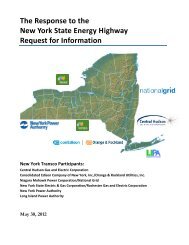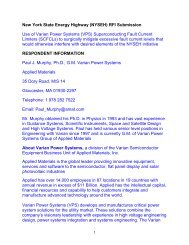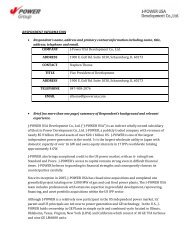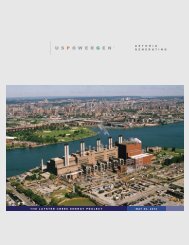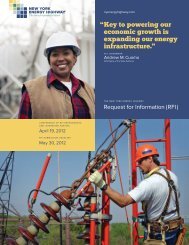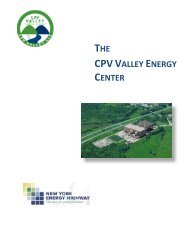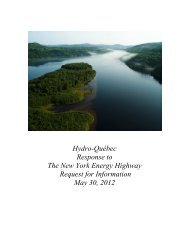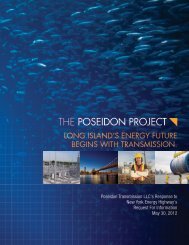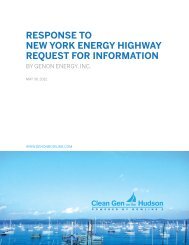Deepwater Wind - Energy Highway
Deepwater Wind - Energy Highway
Deepwater Wind - Energy Highway
Create successful ePaper yourself
Turn your PDF publications into a flip-book with our unique Google optimized e-Paper software.
!<br />
Executive Summary<br />
!<br />
Enabled by the rapid evolution of the offshore wind industry in Northern Europe,<br />
offshore wind farms paired with transmission networks are today cost comparable with<br />
new fossil fuel plants in New York’s Zones K and J, when all important ratepayer<br />
benefits of these projects are considered. These “second generation” projects can now be<br />
built at a larger scale, can access stronger winds that are located in deeper waters far from<br />
shore, and can enable access to neighboring energy markets through the use of innovative<br />
multi-terminal HVDC submarine cable network designs.<br />
The most advanced – and ready for execution – utility-scale offshore wind and<br />
transmission project is the <strong>Deepwater</strong> <strong>Wind</strong> <strong>Energy</strong> Center (“DWEC”), an historic<br />
renewable energy project for New York. DWEC will be a 900 MW offshore wind energy<br />
plant located approximately 30 miles east of Montauk. The 2,900 GWh per year of clean,<br />
renewable energy from DWEC will be delivered into Zone K via a new regional HVDC<br />
submarine transmission system, the New England-Long Island Interconnector (“NELI”).<br />
NELI will, for the first time, connect Zone K with the SEMA zone of ISO-NE, providing<br />
increased system reliability and delivering considerable system benefits to the Long<br />
Island Power Authority (“LIPA”).<br />
<strong>Deepwater</strong> bid this combined DWEC and NELI Project in response to LIPA’s Generation<br />
and Transmission RFP for up to 2,500 MW issued on August 20, 2010. To <strong>Deepwater</strong>’s<br />
knowledge, the bid is still under consideration.<br />
DWEC is scheduled to deliver energy from the offshore wind plant beginning in 2017,<br />
and is therefore the nearest-term utility-scale offshore wind plant in the region. DWEC<br />
enjoys a considerable advantage in its permitting and siting. Over the last three years, a<br />
comprehensive ocean planning and baseline study process has been underway in this<br />
region led by the states of Rhode Island and Massachusetts. This work has made it<br />
possible for a utility-scale offshore wind farm and transmission network to achieve<br />
commercial operations in this ocean area within the next several years allowing this<br />
project to meet the near-term Zone K supply needs identified by LIPA. Moreover,<br />
<strong>Deepwater</strong>’s investments in characterizing the wind resource east of Montauk confirm<br />
that this site is among the most robust wind energy sites on the Atlantic coast.<br />
DWEC represents a near-term opportunity to extend New York’s electricity transmission<br />
infrastructure into nearby federal and state ocean waters and thereby significantly<br />
advance the goals established by the Governor for the <strong>Energy</strong> <strong>Highway</strong>:<br />
• Reduce constraints on the flow of electricity to, and within, the downstate<br />
area; and expand the diversity of power generation sources supplying<br />
downstate. By combining utility-scale offshore wind with new inter-regional<br />
transmission links <strong>Deepwater</strong>’s project will reduce congestion and lower average<br />
!<br />
1




